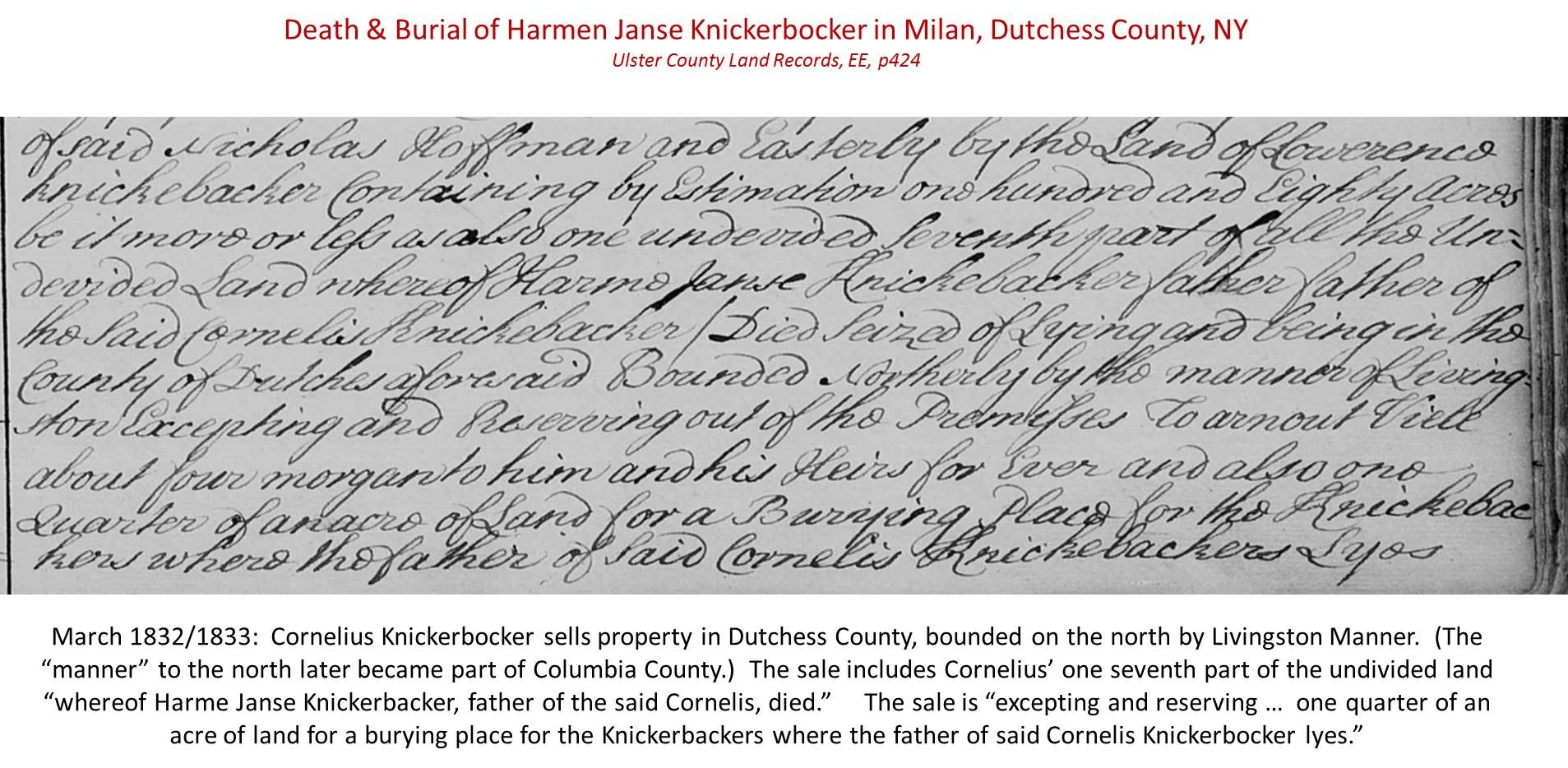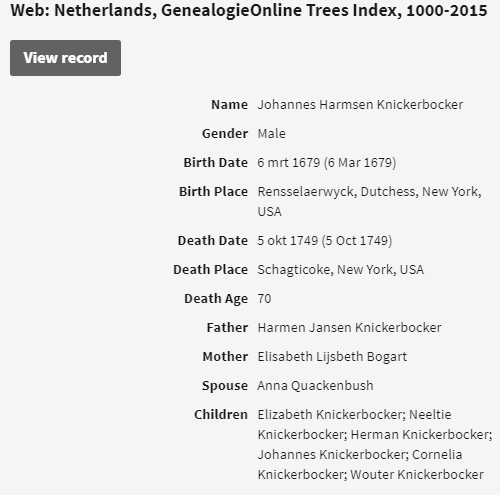Many people have speculated about the death and burial of Harmen Janse Knickerbacker. Here are the facts:
The year of Harmen Janse' death can be found in court records. In a deposition, Peter Knickerbocker, the youngest son of Harmen, stated that his father died in 1714. (See the Law Records of Alexander Hamilton, Volume 3.)
Tax records show that the widow of Harmen Kneeckerbaker paid taxes in Dutchess County in January of 1718, which further proves that Harmen died before 1718. (There are claims on various genealogy sites that Harmen died in 1721. Those claims are wrong.)
The location of Harmen Janse' death can be found in land records. In March of 1733, Cornelius Knickerbocker sold property in Dutchess County that once belonged to his father. The deed describes the property as being "whereof Harme Janse Knickerbacker, father of the said Cornelis, died."
In the same deed, Cornlius Knickerbocker set aside "one quarter of an acre of land for a burying place for the Knickerbackers where the father of said Cornelis Knickerbacker lyes."
This proves that Harmen Janse Knickerbocker died and was buried in Dutchess County.
The location of this quarter acre Knickerbacker burial ground was described in the deed. For example, it was east of the Hudson, north of a "small run of water", and south of the old Lot #2 from when old Knickerbocker lands were subdivided.
Cornelius Knickerbocker preserved the burial ground, but sold all of the surrounding land to the Hoffman family.
Many years later, James H. Smith's "History of Dutchess County" (1882) discussed the history of the Hoffman family. As part of the Hoffman discussion, Mr. Smith documented a small abandoned burial ground behind the Farmer's Hotel. The burial ground's location matches the description from the 1733 deed.
The burial ground included tombstones of Hoffman family members, as well as the degrading tombstone of Lawrence Knickerbocker, who died in 1766. Mr. Smith noted that many stones were missing.
In the years after 1882, a few of the surviving tombstones were supposedly "moved" from the old burial ground. In reality, several tombstones still exist on the bluff. Thus it appears that copies of tombstones were created. It is unclear if any tombstones were actually moved. (Since the tombstones were not moved, it seems very unlikely that any caskets or bodies were actually moved.)
Unfortunately, Harmen Janse's tombstone was already gone, even before 1882. If Harmen's tombstone was ever found or moved, it must have happened before Mr. Smith visited the cemetery.
Anyone interested in looking for the tombstone should note that during his last years Harmen called himself Harmen Boartie, i.e. Harmen the Farmer. (See Alexander Hamilton's law records.) Some variation of "Boartie" probably appeared on Harmen's tombstone.
The Farmer's Hotel was built around 1865. It was on the old Friendship Street in Tivoli, facing the Hudson River. The hotel was torn down in the 1930's to make way for the road now called County Route 78. (Prior to the 1930's, access to the river was on the old "River Road" which was a few hundred yards south of the bluff.)
Many people have speculated about the death and burial of Harmen Janse Knickerbacker. Here are the facts:
The year of Harmen Janse' death can be found in court records. In a deposition, Peter Knickerbocker, the youngest son of Harmen, stated that his father died in 1714. (See the Law Records of Alexander Hamilton, Volume 3.)
Tax records show that the widow of Harmen Kneeckerbaker paid taxes in Dutchess County in January of 1718, which further proves that Harmen died before 1718. (There are claims on various genealogy sites that Harmen died in 1721. Those claims are wrong.)
The location of Harmen Janse' death can be found in land records. In March of 1733, Cornelius Knickerbocker sold property in Dutchess County that once belonged to his father. The deed describes the property as being "whereof Harme Janse Knickerbacker, father of the said Cornelis, died."
In the same deed, Cornlius Knickerbocker set aside "one quarter of an acre of land for a burying place for the Knickerbackers where the father of said Cornelis Knickerbacker lyes."
This proves that Harmen Janse Knickerbocker died and was buried in Dutchess County.
The location of this quarter acre Knickerbacker burial ground was described in the deed. For example, it was east of the Hudson, north of a "small run of water", and south of the old Lot #2 from when old Knickerbocker lands were subdivided.
Cornelius Knickerbocker preserved the burial ground, but sold all of the surrounding land to the Hoffman family.
Many years later, James H. Smith's "History of Dutchess County" (1882) discussed the history of the Hoffman family. As part of the Hoffman discussion, Mr. Smith documented a small abandoned burial ground behind the Farmer's Hotel. The burial ground's location matches the description from the 1733 deed.
The burial ground included tombstones of Hoffman family members, as well as the degrading tombstone of Lawrence Knickerbocker, who died in 1766. Mr. Smith noted that many stones were missing.
In the years after 1882, a few of the surviving tombstones were supposedly "moved" from the old burial ground. In reality, several tombstones still exist on the bluff. Thus it appears that copies of tombstones were created. It is unclear if any tombstones were actually moved. (Since the tombstones were not moved, it seems very unlikely that any caskets or bodies were actually moved.)
Unfortunately, Harmen Janse's tombstone was already gone, even before 1882. If Harmen's tombstone was ever found or moved, it must have happened before Mr. Smith visited the cemetery.
Anyone interested in looking for the tombstone should note that during his last years Harmen called himself Harmen Boartie, i.e. Harmen the Farmer. (See Alexander Hamilton's law records.) Some variation of "Boartie" probably appeared on Harmen's tombstone.
The Farmer's Hotel was built around 1865. It was on the old Friendship Street in Tivoli, facing the Hudson River. The hotel was torn down in the 1930's to make way for the road now called County Route 78. (Prior to the 1930's, access to the river was on the old "River Road" which was a few hundred yards south of the bluff.)
Family Members
Advertisement
Explore more
Sponsored by Ancestry
Advertisement







